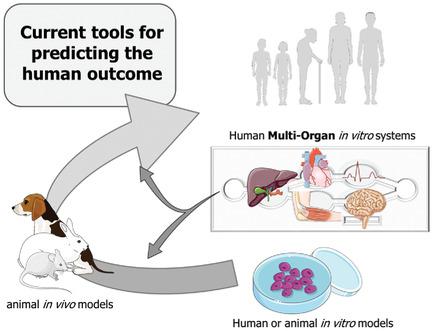当前位置:
X-MOL 学术
›
Adv. Funct. Mater.
›
论文详情
Our official English website, www.x-mol.net, welcomes your
feedback! (Note: you will need to create a separate account there.)
Long‐Term Electrical and Mechanical Function Monitoring of a Human‐on‐a‐Chip System
Advanced Functional Materials ( IF 18.5 ) Pub Date : 2018-12-14 , DOI: 10.1002/adfm.201805792 Carlota Oleaga 1 , Andrea Lavado 1 , Anne Riu 2 , Sandra Rothemund 1 , Carlos A Carmona-Moran 1 , Keisha Persaud 1 , Andrew Yurko 1 , Jennifer Lear 1 , Narasimhan Sriram Narasimhan 3 , Christopher J Long 1, 3 , Frank Sommerhage 1 , L Richard Bridges 3 , Yunqing Cai 1 , Candace Martin 1 , Mark T Schnepper 1 , Arindom Goswami 1 , Reine Note 2 , Jessica Langer 4 , Silvia Teissier 2 , José Cotovio 2 , James J Hickman 1, 3
Advanced Functional Materials ( IF 18.5 ) Pub Date : 2018-12-14 , DOI: 10.1002/adfm.201805792 Carlota Oleaga 1 , Andrea Lavado 1 , Anne Riu 2 , Sandra Rothemund 1 , Carlos A Carmona-Moran 1 , Keisha Persaud 1 , Andrew Yurko 1 , Jennifer Lear 1 , Narasimhan Sriram Narasimhan 3 , Christopher J Long 1, 3 , Frank Sommerhage 1 , L Richard Bridges 3 , Yunqing Cai 1 , Candace Martin 1 , Mark T Schnepper 1 , Arindom Goswami 1 , Reine Note 2 , Jessica Langer 4 , Silvia Teissier 2 , José Cotovio 2 , James J Hickman 1, 3
Affiliation

|
The goal of human‐on‐a‐chip systems is to capture multiorgan complexity and predict the human response to compounds within physiologically relevant platforms. The generation and characterization of such systems is currently a focal point of research given the long‐standing inadequacies of conventional techniques for predicting human outcome. Functional systems can measure and quantify key cellular mechanisms that correlate with the physiological status of a tissue, and can be used to evaluate therapeutic challenges utilizing many of the same endpoints used in animal experiments or clinical trials. Culturing multiple organ compartments in a platform creates a more physiologic environment (organ–organ communication). Here is reported a human 4‐organ system composed of heart, liver, skeletal muscle, and nervous system modules that maintains cellular viability and function over 28 days in serum‐free conditions using a pumpless system. The integration of noninvasive electrical evaluation of neurons and cardiac cells and mechanical determination of cardiac and skeletal muscle contraction allows the monitoring of cellular function, especially for chronic toxicity studies in vitro. The 28‐day period is the minimum timeframe for animal studies to evaluate repeat dose toxicity. This technology can be a relevant alternative to animal testing by monitoring multiorgan function upon long‐term chemical exposure.
中文翻译:

单芯片系统的长期机电功能监测
人类芯片系统的目标是捕捉多器官复杂性并预测人类对生理相关平台内化合物的反应。鉴于预测人类结果的传统技术长期存在不足,此类系统的生成和表征目前是研究的焦点。功能系统可以测量和量化与组织生理状态相关的关键细胞机制,并可用于利用动物实验或临床试验中使用的许多相同端点来评估治疗挑战。在一个平台上培养多个器官隔室创造了一个更具生理性的环境(器官-器官交流)。这里报道了一个由心脏、肝脏、骨骼肌组成的人体 4 器官系统,和神经系统模块,使用无泵系统在无血清条件下保持细胞活力和功能超过 28 天。神经元和心肌细胞的无创电学评估与心脏和骨骼肌收缩的机械测定相结合,可以监测细胞功能,特别是体外慢性毒性研究。28 天是动物研究评估重复给药毒性的最短时间范围。通过监测长期接触化学物质后的多器官功能,该技术可以成为动物试验的相关替代方案。神经元和心肌细胞的无创电学评估与心脏和骨骼肌收缩的机械测定相结合,可以监测细胞功能,特别是体外慢性毒性研究。28 天是动物研究评估重复给药毒性的最短时间范围。通过监测长期接触化学物质后的多器官功能,该技术可以成为动物试验的相关替代方案。神经元和心肌细胞的无创电学评估与心脏和骨骼肌收缩的机械测定相结合,可以监测细胞功能,特别是体外慢性毒性研究。28 天是动物研究评估重复给药毒性的最短时间范围。通过监测长期接触化学物质后的多器官功能,该技术可以成为动物试验的相关替代方案。
更新日期:2018-12-14
中文翻译:

单芯片系统的长期机电功能监测
人类芯片系统的目标是捕捉多器官复杂性并预测人类对生理相关平台内化合物的反应。鉴于预测人类结果的传统技术长期存在不足,此类系统的生成和表征目前是研究的焦点。功能系统可以测量和量化与组织生理状态相关的关键细胞机制,并可用于利用动物实验或临床试验中使用的许多相同端点来评估治疗挑战。在一个平台上培养多个器官隔室创造了一个更具生理性的环境(器官-器官交流)。这里报道了一个由心脏、肝脏、骨骼肌组成的人体 4 器官系统,和神经系统模块,使用无泵系统在无血清条件下保持细胞活力和功能超过 28 天。神经元和心肌细胞的无创电学评估与心脏和骨骼肌收缩的机械测定相结合,可以监测细胞功能,特别是体外慢性毒性研究。28 天是动物研究评估重复给药毒性的最短时间范围。通过监测长期接触化学物质后的多器官功能,该技术可以成为动物试验的相关替代方案。神经元和心肌细胞的无创电学评估与心脏和骨骼肌收缩的机械测定相结合,可以监测细胞功能,特别是体外慢性毒性研究。28 天是动物研究评估重复给药毒性的最短时间范围。通过监测长期接触化学物质后的多器官功能,该技术可以成为动物试验的相关替代方案。神经元和心肌细胞的无创电学评估与心脏和骨骼肌收缩的机械测定相结合,可以监测细胞功能,特别是体外慢性毒性研究。28 天是动物研究评估重复给药毒性的最短时间范围。通过监测长期接触化学物质后的多器官功能,该技术可以成为动物试验的相关替代方案。









































 京公网安备 11010802027423号
京公网安备 11010802027423号